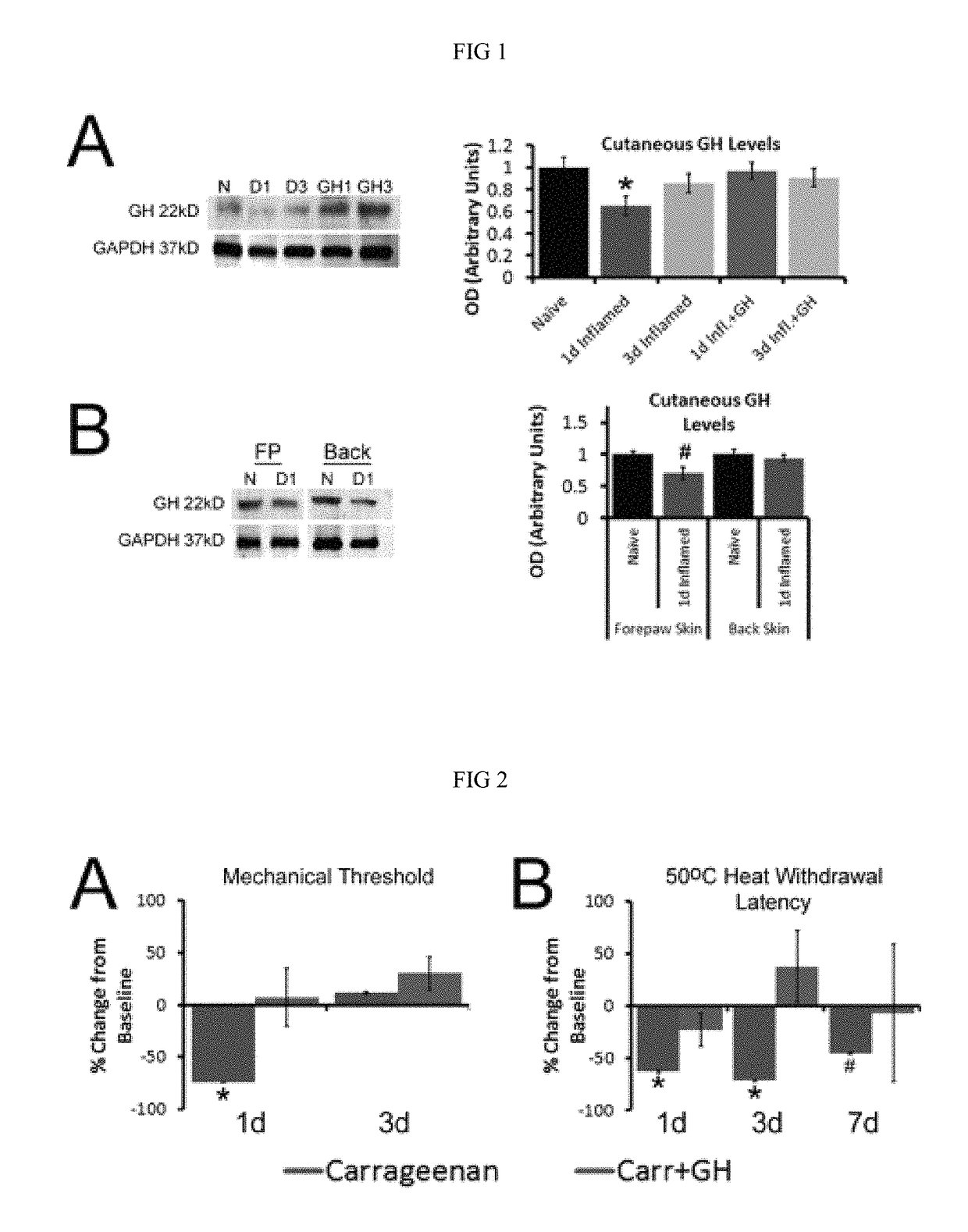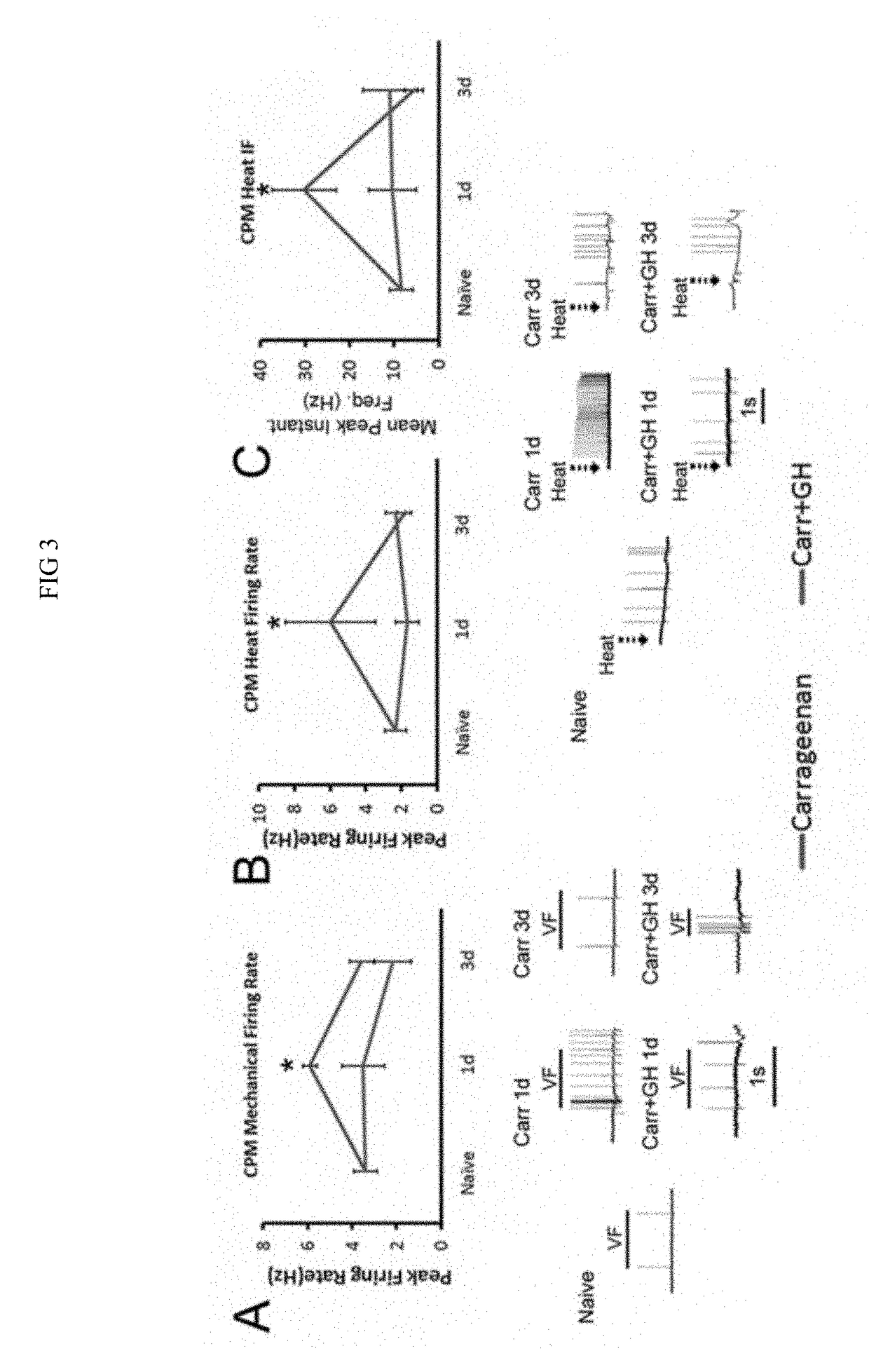Methods for treating pain caused by inflammation induced mechanical and/or thermal hypersensitivity
a technology of mechanical and/or thermal hypersensitivity and pain management, which is applied in the field of pain management of children, can solve the problems of imposing a substantial monetary burden on patients, families, caregivers, and a significant clinical problem in pain management in children
- Summary
- Abstract
- Description
- Claims
- Application Information
AI Technical Summary
Problems solved by technology
Method used
Image
Examples
example 1
[0070]Materials and Methods
[0071]Animals.
[0072]Male and female Swiss Webster mice (Charles River) from postnatal day 6 through 21 (±˜0.5 d around the specified age) were used in these studies. All animals were housed with the mother, which was provided food and water ad libitum and maintained on a 12-hour light / dark cycle. All procedures were approved by the Institutional Animal Care and Use Committee at Cincinnati Children's Hospital Medical Center, under AAALAC approved practices. No differences between male and female mice were detected for any tests described below and thus data was combined from both sexes throughout the manuscript. As Applicant has documented age-related effects of injury on the excitability of primary afferent neurons, Applicant assessed the effects of cutaneous inflammation beginning at two different postnatal ages (P7 or P14) in order to account for any potential developmental effects (Jankowski M P, Ross J L, Weber J D, Lee F B, Shank A T, Hudgins R C. Age...
example 2
[0142]In order to better understand how individual subpopulations of sensory afferents may contribute to pediatric pain states, Applicant recently developed neonatal hairy hindpaw skin / saphenous nerve and neonatal hindpaw muscle / tibial nerve / DRG / SC recording preparations to comprehensively phenotype cutaneous and muscle sensory neurons in mouse (FIG. 2). Using these preparations, Applicant's recent results show changes in afferent subtype prevalence during the course normal postnatal development that differ from adults. This suggests that only particular populations of afferents may have the ability to sensitize to specific modalities after peripheral injury at distinct ages further implying that unique primary afferent based mechanisms of pain generation may occur after injury at different ages.
[0143]Applicant has shown that the injury-evoked changes in afferent sensitivity in distinct subpopulations are age-dependent. In addition to preclinical data, Applicant's clinical data has ...
example 3
[0150]One of the more significant problems with early life injury is not only the pain that comes with the insult, but the long term consequences of such injuries later in life. In addition to the abovementioned data, we also performed studies to assess the utility of a single GH treatment during early life insult to prevent the known priming effects of such injuries on later life hypersensitivity to subsequent re-injury (n=8-12). Results indicate that young adult mice with cutaneous inflammation display a longer lasting hypersensitivity to mechanical and thermal stimuli if they experienced an early life injury (P7 inflammation) compared to mice that only received carrageenan as adults. However, delivery of GH (1.5 mg / kg, ip. 1×) to neonates at the time of neonatal inflammation (no pre-treatment) was able to significantly block this priming effect in the older mice during inflammation in addition to blunting the late stage CPM neuron sensitization observed in mice with dual injury (...
PUM
| Property | Measurement | Unit |
|---|---|---|
| time | aaaaa | aaaaa |
| time | aaaaa | aaaaa |
| time | aaaaa | aaaaa |
Abstract
Description
Claims
Application Information
 Login to View More
Login to View More - R&D
- Intellectual Property
- Life Sciences
- Materials
- Tech Scout
- Unparalleled Data Quality
- Higher Quality Content
- 60% Fewer Hallucinations
Browse by: Latest US Patents, China's latest patents, Technical Efficacy Thesaurus, Application Domain, Technology Topic, Popular Technical Reports.
© 2025 PatSnap. All rights reserved.Legal|Privacy policy|Modern Slavery Act Transparency Statement|Sitemap|About US| Contact US: help@patsnap.com



